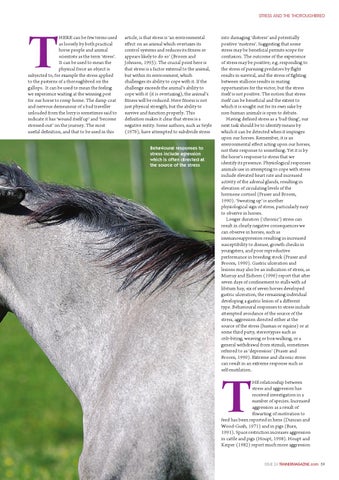STRESS2.qxd:Jerkins feature.qxd
27/11/08
11:41
Page 2
STRESS AND THE THOROUGHBRED
T
HERE can be few terms used as loosely by both practical horse people and animal scientists as the term ‘stress’. It can be used to mean the physical force an object is subjected to, for example the stress applied to the pasterns of a thoroughbred on the gallops. It can be used to mean the feeling we experience waiting at the winning post for our horse to romp home. The damp coat and nervous demeanour of a bad traveller unloaded from the lorry is sometimes said to indicate it has ‘wound itself up’ and ‘become stressed-out’ on the journey. The most useful definition, and that to be used in this
article, is that stress is ‘an environmental effect on an animal which overtaxes its control systems and reduces its fitness or appears likely to do so’ (Broom and Johnson, 1993). The crucial point here is that stress is a factor external to the animal, but within its environment, which challenges its ability to cope with it. If the challenge exceeds the animal’s ability to cope with it (it is overtaxing), the animal’s fitness will be reduced. Here fitness is not just physical strength, but the ability to survive and function properly. This definition makes it clear that stress is a negative entity. Some authors, such as Seyle (1976), have attempted to subdivide stress Behavioural responses to stress include agression which is often directed at the source of the stress
into damaging ‘distress’ and potentially positive ‘eustress’. Suggesting that some stress may be beneficial permits scope for confusion. The outcome of the experience of stress may be positive; e.g. responding to the stress of pursuing predators by flight results in survival, and the stress of fighting between stallions results in mating opportunities for the victor, but the stress itself is not positive. The notion that stress itself can be beneficial and the extent to which it is sought out for its own sake by non-human animals is open to debate. Having defined stress as a ‘bad thing’, our next task should be to identify means by which it can be detected when it impinges upon our horses. Remember, it is an environmental effect acting upon our horses, not their response to something. Yet it is by the horse’s response to stress that we identify its presence. Physiological responses animals use in attempting to cope with stress include elevated heart rate and increased activity of the adrenal glands, resulting in elevation of circulating levels of the hormone cortisol (Fraser and Broom, 1990). ‘Sweating up’ is another physiological sign of stress, particularly easy to observe in horses. Longer duration (‘chronic’) stress can result in clearly negative consequences we can observe in horses, such as immunosuppression resulting in increased susceptibility to disease, growth checks in youngsters, and poor reproductive performance in breeding stock (Fraser and Broom, 1990). Gastric ulceration and lesions may also be an indication of stress, as Murray and Eichorn (1996) report that after seven days of confinement to stalls with ad libitum hay, six of seven horses developed gastric ulceration, the remaining individual developing a gastric lesion of a different type. Behavioural responses to stress include attempted avoidance of the source of the stress, aggression directed either at the source of the stress (human or equine) or at some third party, stereotypies such as crib-biting, weaving or box-walking, or a general withdrawal from stimuli, sometimes referred to as ‘depression’ (Fraser and Broom, 1990). Extreme and chronic stress can result in an extreme response such as self-mutilation.
T
HE relationship between stress and aggression has received investigation in a number of species. Increased aggression as a result of thwarting of motivation to feed has been reported in hens (Duncan and Wood-Gush, 1971) and in pigs (Bure, 1991). Space restriction increases aggression in cattle and pigs (Houpt, 1998). Houpt and Keiper (1982) report much more aggression
ISSUE 24 TRAINERMAGAZINE.com 59
